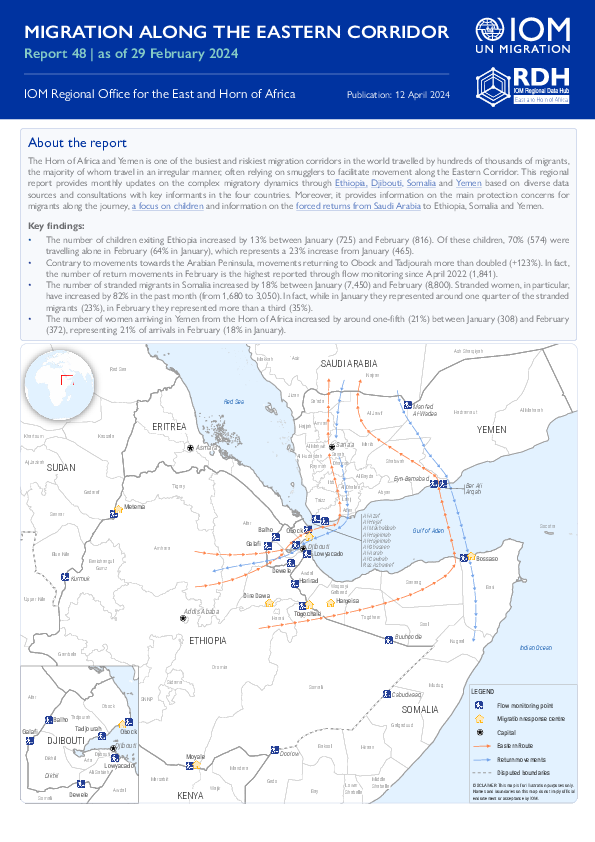-
Countries
-
Data and Analysis
-
Special Focus
-
Crisis Responses
Flow Monitoring
• The number of children exiting Ethiopia increased by 13% between January (725) and February (816). Of these children, 70% (574) were
travelling alone in February (64% in January), which represents a 23% increase from January (465).
• Contrary to movements towards the Arabian Peninsula, movements returning to Obock and Tadjourah more than doubled (+123%). In fact,
the number of return movements in February is the highest reported through flow monitoring since April 2022 (1,841).
• The number of stranded migrants in Somalia increased by 18% between January (7,450) and February (8,800). Stranded women, in particular, have increased by 82% in the past month (from 1,680 to 3,050). In fact, while in January they represented around one quarter of the stranded migrants (23%), in February they represented more than a third (35%).
• The number of women arriving in Yemen from the Horn of Africa increased by around one-fifth (21%) between January (308) and February
(372), representing 21% of arrivals in February (18% in January).

Contact
DTMCostaRica@iom.int
Language
English
Location
Costa Rica
Period Covered
Mar 01 2024
Mar 31 2024
Activity
- Flow Monitoring
- Mobility Tracking
- Event Tracking
Cantons: Alajuela, Alajuelita, Cartago, Desamparados, Escazú, Corredores, Heredia, Los Chiles, San Carlos, San José, Santa Ana, Santo Domingo, Tibás
Costa Rica, like the other countries in the Central American region, has been characterized as a migratory corridor for people who transit by land from the south to the north of America and whose destination is the countries in the north of the continent. This flow on the move through the Americas is mainly made up of people from the Bolivarian Republic of Venezuela, Cuba, Haiti, Ecuador, as well as people from other countries in South America, Africa and Asia.
According to estimations from IOM Costa Rica, during March 36,106 people entered the country, an approximate average of 1,165 people per day and estimating a decrease of 13% compared to February 2024. In addition, 1,178 people stranded in the monitored shelters were identified and 872 people stranded in the public places visited.

Contact
DTM Europe, DTMMediterranean@iom.int
Language
English
Location
Estonia
Period Covered
Mar 01 2023
Dec 31 2023
Activity
- Survey
- Flow Monitoring
This report is based on a survey of displacement patterns, needs and intentions conducted by IOM’s Displacement Tracking Matrix (DTM) in the 11 countries included in the Regional Response Plan for Ukraine in 2023: 6 countries neighboring Ukraine – Belarus, Hungary, Poland, Republic of Moldova, Romania and Slovakia – and other 5 countries particularly impacted by the arrivals of refugees from Ukraine since the start of the war in February 2022 – Bulgaria, Czechia, Estonia, Latvia and Lithuania.
The analysis provided in this report is based on annual data collected from March to December 2023.
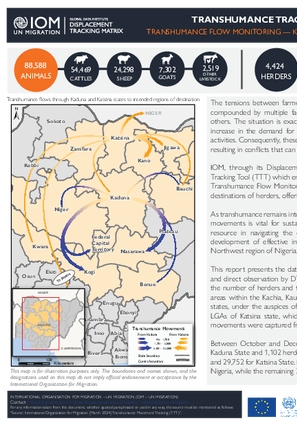
Contact
DTM Nigeria, iomnigeriadtm@iom.int
Language
English
Location
Nigeria
Period Covered
Oct 01 2023
Dec 31 2023
Activity
- Survey
- Flow Monitoring
This report presents the data collected between October and December 2023, through direct interviews and direct observation by DTM enumerators and triangulated via a network of key informants. It highlights the number of herders and their herds identified at 45 counting points. Between October and December 2023, the Transhumance Flow Monitoring tool identified 3,322 herders in Kaduna State and 1,102 herders in Katsina State. The animal count was estimated at 58,836 for Kaduna State and 29,752 for Katsina State. Notably, 80 per cent of the total number of herders departed from states within Nigeria, while the remaining 20 per cent departed from Niger.
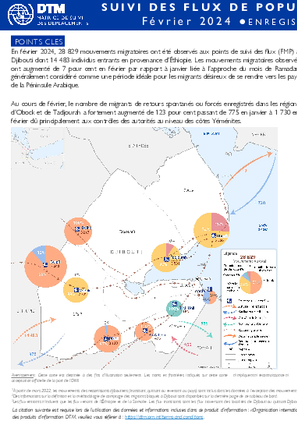
Contact
DTM Djibouti, DTMDjibouti@iom.int
Language
English
Location
Djibouti
Period Covered
Feb 01 2024
Feb 29 2024
Activity
- Flow Monitoring
En février 2024, 28 829 mouvements migratoires ont été observés aux points de suivi des flux (FMP) à Djibouti dont 14 483 individus entrants en provenance d’Éthiopie. Les mouvements migratoires observés ont augmenté de 7 pour cent en février par rapport à janvier liée à l’approche du mois de Ramadan généralement considéré comme une période idéale pour les migrants désireux de se rendre vers les pays
de la Péninsule Arabique.
Au cours de février, le nombre de migrants de retours spontanés ou forcés enregistrés dans les régions d’Obock et de Tadjourah a fortement augmenté de 123 pour cent passant de 775 en janvier à 1 730 en février dû principalement aux contrôles des autorités au niveau des côtes Yéménites.

Contact
DTM Djibouti, DTMDjibouti@iom.int
Language
English
Location
Djibouti
Period Covered
Feb 01 2024
Feb 29 2024
Activity
- Flow Monitoring
In February 2024, 28,829 migratory movements were observed at Djibouti's Flow Monitoring Points (FMPs), including 14,483 incoming individuals from Ethiopia. The observed migratory movements increased by 7 per cent in February compared with January, linked to the approach of the month of Ramadan, generally considered to be an ideal time for migrants wishing to travel to the countries in the Arabian
Peninsula.
During February, the number of spontaneous or forced return migrants recorded in the Obock and Tadjourah regions rose sharply by 123 per cent, from 775 in January to 1,730 in February, mainly due to checks by the authorities on the Yemeni coast.
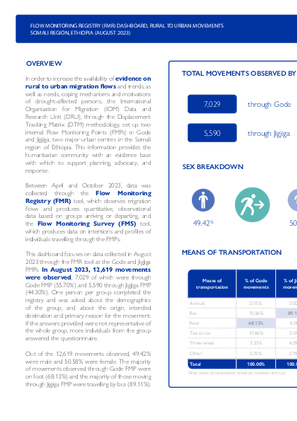
Contact
DTM Ethiopia, DTMEthiopia@iom.int
Language
English
Location
Ethiopia
Period Covered
Aug 01 2023
Aug 31 2023
Activity
- Flow Monitoring
In order to increase the availability of evidence on rural to urban migration flows and trends, as well as needs, coping mechanisms and motivations of drought-affected persons, the International Organization for Migration (IOM) Data and Research Unit (DRU), through the Displacement Tracking Matrix (DTM) methodology, set up and piloted two internal Flow Monitoring Points (FMPs) in Gode and Jigjiga, two major urban centres in the Somali region of Ethiopia. The pilot ran from June 2023 through August 2023.
This dashboard focuses on data collected in August 2023 through the FMR tool in Gode and Jigjiga FMPs. In August 2023, 12,619 movements were observed, 7,029 of which were through Gode FMP (55.70%) and 5,590 through Jigjiga FMP (44.30%).

Contact
DTM Ethiopia, DTMEthiopia@iom.int
Language
English
Location
Ethiopia
Period Covered
Feb 01 2024
Feb 29 2024
Activity
- Flow Monitoring
In February 2024, a total of 36,277 movements were observed across the six flow monitoring points (FMPs) in Ethiopia. This represents a 4.2% decrease in daily average movements in comparison with January 2024 when an average of 1,305 movements per day were observed.
The ratio between outgoing movements (63%) during February and incoming movements (37%) remained the same as the previous month. A total of 22,762 outgoing movements were observed, out of which 10,954 (48.1%) were heading to Saudi Arabia, 4,689 (20.6%) were going to Kenya, 2,029 (8.9%) to Djibouti, 1,367 (6%) to Somalia, 1,105 (4.9%) to South Africa, 859 (3.8%) to Yemen, and 668 (2.9%) to Sudan, while remaining movements were heading to other Southern African, Middle Eastern, North American and European countries.
At the same time, 13,515 incoming movements were observed, out of which 8,763 (64.9%) originated from Sudan, while 2,276 (16.8%) came from Kenya, 1,393 (10.3%) from Djibouti, 790 (5.8%) from Somalia and 293 (2.2%) came from other Middle Eastern and African countries. Most incoming movements were by Ethiopians (67.1%), followed by Sudanese nationals (31.4%). Returning Ethiopians departed from Sudan (48%), Kenya (25%), Djibouti (15.1%), Somalia (8.7%), Yemen (2%), Saudi Arabia (1.1%) and Tanzania (0.1%).
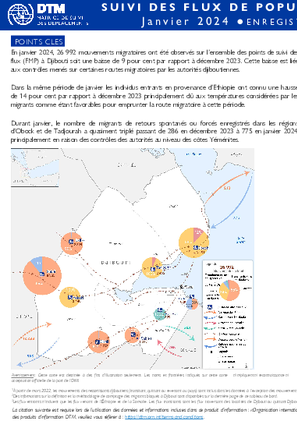
Contact
DTM Djibouti, DTMDjibouti@iom.int
Language
English
Location
Djibouti
Period Covered
Jan 01 2024
Jan 31 2024
Activity
- Flow Monitoring
En janvier 2024, 26 992 mouvements migratoires ont été observés sur l’ensemble des points de suivi des flux (FMP) à Djibouti soit une baisse de 9 pour cent par rapport à décembre 2023. Cette baisse est liée aux contrôles menés sur certaines routes migratoires par les autorités djiboutiennes. Dans la même période de janvier les individus entrants en provenance d’Ethiopie ont connu une hausse de 14 pour cent par rapport à décembre 2023 principalement dû aux températures considérées par les migrants comme étant favorables pour emprunter la route migratoire à cette période.
Durant janvier, le nombre de migrants de retours spontanés ou forcés enregistrés dans les régions d’Obock et de Tadjourah a quasiment triplé passant de 286 en décembre 2023 à 775 en janvier 2024, principalement en raison des contrôles des autorités au niveau des côtes Yéménites.

Contact
DTM Djibouti, DTMDjibouti@iom.int
Language
English
Location
Djibouti
Period Covered
Jan 01 2024
Jan 31 2024
Activity
- Flow Monitoring
In January 2024, 26,992 migratory movements were observed at all Djibouti's Flow Monitoring Points (FMPs) with a decrease of 9 per cent compared with December 2023. This drop is linked to the controls carried out on certain migration routes by the Djibouti authorities. During the same period in January, the number of people entering Djibouti from Ethiopia rose by 14 per cent compared with December 2023, mainly due to the temperatures which migrants consider to be favourable for taking the migration route at this time of year. During January, the number of spontaneous or forced returnees recorded in the Obock and Tadjourah regions almost tripled, rising from 286 in December 2023 to 775 in January 2024, mainly due to controls by the authorities on the Yemeni coast.
Pagination
- Previous page
- Page 19
- Next page
